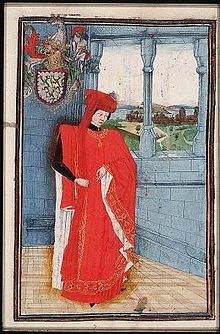Hugo van Lannoy
- Machine translation, like DeepL or Google Translate, is a useful starting point for translations, but translators must revise errors as necessary and confirm that the translation is accurate, rather than simply copy-pasting machine-translated text into the English Wikipedia.
- Consider adding a topic to this template: there are already 6,214 articles in the main category, and specifying
|topic=will aid in categorization. - Do not translate text that appears unreliable or low-quality. If possible, verify the text with references provided in the foreign-language article.
- You must provide copyright attribution in the edit summary accompanying your translation by providing an interlanguage link to the source of your translation. A model attribution edit summary is
Content in this edit is translated from the existing French Wikipedia article at [[:fr:Hugues de Lannoy]]; see its history for attribution. - You may also add the template
{{Translated|fr|Hugues de Lannoy}}to the talk page. - For more guidance, see Wikipedia:Translation.

Hugo van Lannoy (French: 'Hue' or 'Hugues de Lannoy'; 1384 – 1 May 1456), Lord of Santes, was a Flemish statesman in the service of the Dukes of Burgundy, most notably Philip III who founded the Order of the Golden Fleece.
Biography
He was a member of the noble de Lannoy family. He was the son of Guillebert I van Lannoy and Catherine of Molembais.
His brothers were Guillebert of Lannoy and Baldwin of Lannoy, also founding Knights of the Golden Fleece. As a young knight, he travelled to Jerusalem and joined an expedition against the Tatars, who occupied Muscovy. Back in Europe, he served John the Fearless. Hugo also fought in 1415 against the English in the Battle of Azincourt, where he was captured.
After his release, he entered as a diplomat in the service of Philip the Good and helped arrange the marriage between Jacqueline, Countess of Holland and Humphrey of Gloucester.

When Jacqueline married in secret with Frank van Borssele, Philip the Good annexed the counties of Holland, Zeeland and Hainaut. Hugo van Lannoy became the first Burgundian Stadtholder of Holland and Zeeland.[1]
At the age of 68, Hugo fought against the Revolt of Ghent (1449–1453) between 1452 and 1453. He died without children and was buried in Lille.
References
- ^ Putnam, Ruth (1904). A Mediaeval Princess: Being a True Record of the Changing Fortunes which Brought Divers Titles to Jacqueline, Countess of Holland, Together with an Account of Her Conflict with Philip, Duke of Burgundy ( 1401-1436). G.P. Putnam's Sons. p. 242.
- v
- t
- e
- Hugo van Lannoy
- Willem van Lalaing
- Gozewijn de Wilde
- Jean de Lannoy
- Lewis de Bruges
- Wolfert VI van Borselen
- Joost van Lalaing
- Jan III van Egmond
- Henry III of Nassau-Breda
- Antoon van Lalaing
- René of Châlon
- Louis of Flanders
- Maximilian II of Burgundy
- William of Orange
- Maximilian of Hennin
- Philip of Noircarmes
- William of Orange
- Adolf van Nieuwenaar (Utrecht only)
- Maurice of Nassau
- Frederick Henry of Orange
- William II of Orange
- interregnum
- William III of Orange
- interregnum
- William IV of Orange
- William V of Orange











